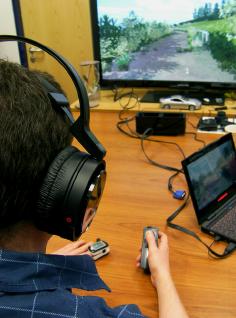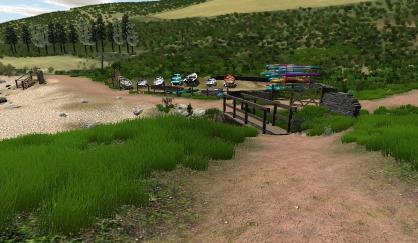“I have been involved in hospital projects before and some patients have very nice views onto leafy lanes, but some look out onto bricks and mortar and glass and steel, and others have no view at all. It is all well and good for those who have a nice outlook, but what about those who don't?”
This dilemma posed by Professor Bob Stone is the reason why his team of researchers from the School of Electronic, Electrical and Computer Engineering at the University of Birmingham are currently exploring how they can capture sights, sounds and smells to create virtual scenarios that can be used on hospital wards or in care homes and rehabilitation centres to improve the lives of patients and, potentially, enhance their recovery.
This project aims to exploit simulated restorative environments to deliver similar benefits to those individuals who are unable to access and experience real natural environments, such as those in hospitals or civilian and military rehabilitation centres
The technology is being developed by post-graduate students at the university following a request from the Ministry of Defence, which wants to explore the possibility of using innovative systems to help with the treatment of service personnel injured in action. However, if proven to have a therapeutic effect, it could also have much wider implications for the NHS as a whole.
This technology could be made available to anyone who, for whatever reason, is in hospital, bed-bound or cannot get outside
“This technology could be made available to anyone who, for whatever reason, is in hospital, bed-bound or cannot get outside,” says Stone. Essentially what the researchers have come up with are two virtual worlds based on reconstructions of real-life beauty spots – Wembury Bay in Plymouth and Burrator Reservoir in Dartmoor. Using high-resolution aerial imagery of the sites, the resulting technology shows the environments as they would be seen, with realistic sound effects helping to transport patients into the outside world and enable them to keep track of the time of day and possibly even the changing of the seasons.
Stone explains: “Just from showing these virtual worlds to people and watching their immediate reaction has been very encouraging for us. “For example, one morning I went to my office and my cleaner, who said she'd had a bad night, was sitting in front of the screen with Wembury Bay on it. She said she felt so much better, and that's encouraging.
The project is focusing on the exploitation of virtual environments so that additional features can be added on a regular basis, including things like seasonal changes and time-of-day effects, as well as allowing end users to choose their own locations, including possibly underwater or in the air
“I also showed it to my 83-year-old mother, who has macular degeneration, and she was able to make out the familiar sights and features of Wembury Bay. She just lay back and listened.
“The jury is still out on just how much detail we should go into, but we have been given encouragement on an informal basis.”
The reasoning behind the research is based on studies conducted since the late 1970s which suggest that exposing people to natural environments such as rural and coastal settings, and smaller-scale urban areas with natural features, can promote a feeling of wellbeing, reduce stress, and enhance mental recovery. As such, ‘restorative environments’ are now widely recognised as powerful tools in the treatment of a range of psychological conditions.
Stone says: “This project aims to exploit simulated restorative environments to deliver similar benefits to those individuals who are unable to access and experience real natural environments, such as those in hospitals or civilian and military rehabilitation centres presenting with a variety of psychological conditions like depression, pain and sleep deficit.”
The possibilities are seemingly endless, but we need to know just how far we should go, or whether we would have exactly the same effect just by using existing gaming technology
The research is being extended in collaboration with the Royal Centre for Defence Medicine and Queen Elizabeth Hospital Birmingham and will explore the potential impact of incorporating rehabilitative activities such as canoeing, playing golf or jogging on recovery.
Professor Stone says: “We already do simulation work with the Armed Force using gaming technology. We are now considering how this could be improved to have a restorative effect post operatively. For example, maybe we could help amputees maintain their muscles during recovery. Since injured servicemen can spend a lot of time in NHS hospitals before they go to Headley Court Military Hospital, by the time they get there they often have significant muscle atrophy. Using this technology we may be able to improve the outlook and speed up recovery. We are also evaluating the possibility of using new techniques to combat phantom limb pain among amputees.”
To this end, the research is focusing on the development of a suite of wearable and wireless measurement sensors that record skin response, heart rate and basic electroencephalography.
“This project is focusing on the exploitation of virtual environments so that additional features can be added on a regular basis, including things like seasonal changes and time-of-day effects, as well as allowing end users to choose their own locations, including possibly underwater or in the air.
“The possibilities are seemingly endless, but we need to know just how far we should go, or whether we would have exactly the same effect just by using existing gaming technology.”

After creating the initial systems, the team is now embarking on an evaluation which will result in the publication of a White Paper for the Ministry of Defence at the end of this year. Between now and then, the researchers are keen to link up with other hospitals across the country to expose the technology to as many people as possible.
“We will first be using non-hospitalised patients with the aim of producing results to confirm that these virtual environments can effect similar psychological changes to their real-world counterparts,” Stone explains. “We are also engaging with military patients, exposing them to early versions to emphasise the rationale behind the sedate nature of the environments and to seek their input with regard to future interactive developments.”
And he said that, if the research supports the virtual environments as a useful tool in improving health outcomes, it could mark the beginning of a new era for the NHS.

“The software we have developed is available free of charge with no licence fee, so it is within the reach of NHS trusts,” he added. “While we are working with the Ministry of Defence, it is keen to roll it out to the civilian sector. “I certainly think it is suitable for the NHS as all that is needed is a laptop and a screen, so there is no major financial outlay. I certainly believe there are also funding possibilities within the EU, defence industry and in academic circles. Despite the current economic landscape, I do not think this is out of range of our health service.”
